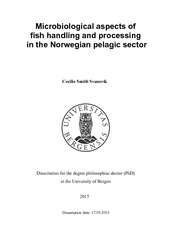| dc.contributor.author | Svanevik, Cecilie Smith | eng |
| dc.date.accessioned | 2015-08-24T11:56:49Z | |
| dc.date.available | 2015-08-24T11:56:49Z | |
| dc.date.issued | 2015-03-17 | |
| dc.identifier.uri | https://hdl.handle.net/1956/10344 | |
| dc.description.abstract | Most global marine fish resources seem to have reached their limit of sustainable exploitation, whereas the demand for high quality fish products is still increasing. The fish sector needs to comply with the growing market by optimising the utilization of fish that have been harvested already, as approx. 10 - 25% of the total global wild-captured fish are rejected from the market. Microorganisms play an important role in product quality reduction, and an increased knowledge of the bacteria associated with fish, is needed. The overall aim of the work included in this thesis was to describe the bacteria associated with pelagic fish, to better utilise the fish and ensure quality and safety. The indigenous bacterial biota of gills, skin and intestinal content from Atlantic mackerel (Scomber scombrus), as well as in the intestinal content of blue whiting (Micromesistius poutassou), were described by cultivation and PCRDGGE methods. These samples were dominated by Gram-negative bacteria. The frequently occurring parasitic nematode larva of the genera Anisakis enters the fish through the intestine. The bacterial biota of these larvae was therefore expected to reflect the bacterial biota found in the fish intestine, and the shared bacterial genera comprised of Pseudoalteromonas, Psychrobacter, Photobacterium, and Pseudomonas. The latter two are known to cause spoilage in fresh fish. During capture, landing and processing, the fish become exposed to extrinsic factors in the production environment that might affect the bacterial biota and possibly the quality of the fish. A spot sampling programme was performed at fishing vessels and fish processing factories over a ten years period (2005-2014). The microbiological conditions of fish, surfaces of equipment and water samples was analysed by quality, hygiene and safety parameters. Samples were assessed according to a proposed assessment scheme, and good hygiene and safety conditions were found at 19 of 41 samplings. Contamination by the human pathogen Listeria monocytogenes was detected in fish from three samplings, and on equipment at nine samplings. One sampling on board a fishing vessel showed contamination by E. coli in the refrigerated sea water (RSW) tanks and on the fish, and this is of concern, since any contamination that occur early in the production chain might follow the fish throughout the process. The effect of pumping of fish on board vessels was examined by comparing samples of Atlantic mackerel collected from the purse seine and the RSW tanks, 12 hour post capture. During the pumping intestinal content is forced out of the fish, contaminating the outer surfaces such as gills and skin of the surrounding fish. This is shown by the increased bacterial load on Iron Agar Lyngby (IAL) found in gill- and skin samples of fish collected from the RSW tank. Additionally, the genera Vibrio and Oceanisphaera were only identified in intestine samples from fish collected from the purse seine, but in all samples from fish collected from the RSW tank. The muscle-invading Anisakis larvae were suspected to carry bacteria into the assumed sterile fish muscle. The presence of bacteria in larvae excised from fish muscle, was confirmed by Gram-stained histology sections. Samples from blue whiting muscle, with and without Anisakis larvae, were cultured and showed that the parasite acts as a contaminating vector, increasing the bacterial load in the fish muscle. However, these bacteria are not likely to be spread within the fish muscle unless the fish is processed in a way that disrupt the capsule and the parasite, as for instance during fish mincing. A follow-up study included a 15-days long storage trial with fish mince inoculated with an Anisakis homogenate. The study gave surprisingly positive results, as the heterotropic plate count (HPC) were lower and the shelf-life was prolonged when the fish mince was added the Anisakis-homogenate. These results show that fish that are infected with parasite larvae, should not necessarily be excluded as a food resource. | en_US |
| dc.language.iso | eng | eng |
| dc.publisher | The University of Bergen | en_US |
| dc.relation.haspart | Paper I: Svanevik, C.S., Roiha, I.S., Lunestad, B.T. and Levsen, A. Microbiological assessment along the fish production chain of the Norwegian pelagic fisheries sector - results from a spot sampling programme. Food Microbiology 51: 144 -153. The article is available at: <a href="http://hdl.handle.net/1956/10339" target="blank">http://hdl.handle.net/1956/10339</a>. | en_US |
| dc.relation.haspart | Paper II: Svanevik, C.S. and Lunestad, B.T. (2011). Characterisation of the microbiota of Atlantic mackerel (Scomber scombrus). International Journal of Food Microbiology, 151 (2):164-170. Full text not available in BORA due to publisher restrictions. The article is available at: <a href="http://dx.doi.org/10.1016/j.ijfoodmicro.2011.08.016" target="blank">http://dx.doi.org/10.1016/j.ijfoodmicro.2011.08.016</a>. | en_US |
| dc.relation.haspart | Paper III: Svanevik, C.S., Levsen, A. and Lunestad, B.T. (2013). The role of muscle-invading anisakid larvae on bacterial contamination of the flesh of post-harvest blue whiting (Micromesistius poutassou). Food Control, 30 (2):526-530. Full text not available in BORA due to publisher restrictions. The article is available at: <a href="http://dx.doi.org/10.1016/j.foodcont.2012.08.003" target="blank">http://dx.doi.org/10.1016/j.foodcont.2012.08.003</a>. | en_US |
| dc.relation.haspart | Paper IV: Svanevik, C.S., Lunestad, B.T. and Levsen, A. (2014). Effect of Anisakis simplex (sl) larvae on the spoilage rate and shelf-life of fish mince products under laboratory conditions Food Control, 46 (12):121-126. The article is available at: <a href="http://hdl.handle.net/1956/10340" target="blank">http://hdl.handle.net/1956/10340</a>. | en_US |
| dc.subject | Anvendt mikrobiologi | NOB |
| dc.subject | Holdbarhet | NOB |
| dc.subject | Parasittiske nematoder | NOB |
| dc.subject | Fiskeprodukter | NOB |
| dc.title | Microbiological aspects of fish handling and processing in the Norwegian pelagic sector | en_US |
| dc.type | Doctoral thesis | |
| dc.rights.holder | Copyright the Author. All rights reserved | en_US |
| dc.identifier.cristin | 1231154 | |
